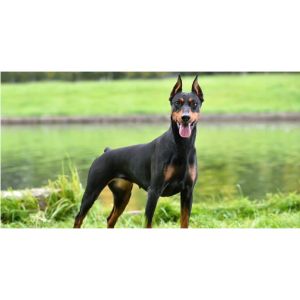
The Doberman Belgian Malinois mix is a crossbreed that is half Doberman and half Belgian Malinois.
With their sharp but cute appearance and fierce personalities, they can make great companions – for the right family. Let’s take a look at everything you need to know to help you decide whether or not they’re right for you!
Other articles you would like: Should I Get A Male Or Female Belgian Malinois? and Do Belgian Malinois Shed?
Table of Contents
Belgian Malinois vs Doberman

The main similarities between Belgian Malinois and Doberman dogs are their size, smooth, streamlined appearance, and bold and brave personalities.
However, the Doberman is slightly larger in size by a couple of inches and typically weighs around 20 lbs more than the Belgian Malinois.
They also have a slightly lesser need for rigorous mental and physical exercise, and because of the Belgian Malinois’ high prey drive, the Doberman is also a bit better at living in homes with other pets – with lots of socialization.
All about the Belgian Malinois Doberman mix

As a recent creation, the Doberman Belgian Malinois mix doesn’t have much of a history to speak of, but they are growing in popularity, thanks to the fashionability of “designer” or mixed breeds.
Size
The Belgian Malinois Doberman mix is a large dog. The average male is 22-26 inches (55-66 cm) tall and weighs between 60-80 lbs (27-36 kgs), whilst the average female stands at 21-24 inches (21-60 cm) tall and weighs around 40-70 lbs (18-31 kgs).
When is a Belgian Malinois Doberman mix fully grown?
Belgian Malinois Doberman mix puppies are born in litters averaging 6-8 puppies, although they can be bigger or smaller.
They grow to reach their full adult size by around 2 years or 24 months of age; although they reach their full adult height a little earlier at 12-18 months, but they continue to fill out weight-wise until they’re about two years old.
They also enter adolescence at around 6-9 months of old, reach sexual maturity by about 9-11 months, and full mental maturity by 2 years of age.
Appearance
Belgian Malinois Doberman mixes are large, tall dogs with slim but strong frames and pointy heads, long snouts, big brown eyes, and large pointy upright ears.
They are a perfect visual mix of the two breeds, with long legs and tails and short, smooth coats, but their most distinguishing feature is by far their fabulous ears!
What color are Belgian Malinois Doberman mixes?
Belgian Malinois Doberman mixes are typically black with brown markings, but they can also be totally black, or more brown than black.
Their markings often include facial and mask markings, eyebrow markings, eyebrow markings, and markings on the legs and chest.
Coat type

The Belgian Malinois Doberman mix has a short double coat consisting of a coarse outer layer and a softer, thicker, insulating undercoat.
Their fur is straight and smooth in texture, measuring 1-2 inches in length, and it is the same length and texture all over their bodies.
Are they heavy shedders?
Belgian Malinois Doberman mixes are moderate shedders all-year round, but they shed particularly heavily during the so-called “shedding seasons”.
Or in the 2-4 week transition from spring to summer and fall to winter, in which they shed their old seasonal coat to make way for a new seasonally appropriate one.
Are they hypoallergenic?
Belgian Malinois Doberman mixes are not classed as hypoallergenic dogs, because they shed a significant amount of hair and would definitely trigger symptoms in anyone with allergies to pet hair.
However, there are things you can do to reduce their shedding if you’re desperate to own one, such as using de-shedding supplements and shampoos, but you can’t stop them from shedding altogether.
Temperament
Doberman Belgian Malinois dogs are lively, bold, brave, and intelligent dogs. In fact, one-half of their parent breeds, the Doberman, is the 5th smartest dog breed in the world, so you can expect them to need a lot of stimulation.
They’re also loving, loyal, dominant, and protective dogs, especially toward their family members, but they can be a little suspicious of strangers and unfamiliar dogs without lots of socialization.
Do Doberman Belgian Malinois dogs get bored?
As mentioned above, these dogs are very intelligent, so they can get bored easily.
It’s important to provide them with lots of mental stimulation through fun play and challenging games and toys like hide and seek, treasure hunt, puzzles, sensory toys, and treat dispensers to ensure that they don’t get bored.
In such bright, high-energy dogs as the Belgian Malinois Doberman, boredom and pent-up energy can easily turn into frustration and anxiety.
Which can lead to destructive behaviors like excessive barking, going to the toilet indoors, ripping up household furniture, and even aggression.
Are they good family dogs?
The Doberman Belgian Malinois mix can make great family dogs for the right family.
If you can commit to their training and socialization and give them what they need on a daily basis, they will be the most loyal, loving, protective family dog that you can imagine.
They can also be good with children when raised with them from an early age, and they’re very outdoorsy dogs, so they’re the perfect companions for family walks, vacations, and camping trips!
That said, they can be a little bit boisterous for small and very young children, so supervision is advised and every child should be taught how to interact with their pets safely and respectfully.
Training

Just because these dogs are known for being bright, doesn’t mean that training is always easy. They’re also known for being quite stubborn and as discussed above, they get bored easily.
So, their training sessions should be short and to the point, with lots of consistency and fun rewards, with lots of positive reinforcement to avoid boredom and stubborn behaviors.
You should never punish your Doberman Belgian Malinois pup for getting it wrong, and try using a behavioral signal like a clicker to speed up the learning process if it’s taking a little longer than expected.
Remember to start with the basics, like sit and stay and focus on obedience, recall training, and socialization to prevent their stubborn and dominant streak from taking over their behavior.
Diet
Like every dog, the Doberman Belgian Malinois mix should eat nutritiously complete and balanced food for large, active dogs that contain all of the key nutrients they need to support whole body health and wellness.
This includes vitamins like A, B, C, E, and K for healthy vision and internal organs, minerals like magnesium and calcium for bone muscle, heart, cellular, and brain health, and lean protein sources like chicken for strong muscles.
As well as healthy carbohydrates like rice for energy, antioxidants from fruits and veggies for preventative health, and healthy fats like Omega fatty acids from oily fish to nourish their coats, minds, and joints.
You may also want to consider foods with added probiotics if your dog has a sensitive system and foods that have been slow-cooked or freeze-dried for better taste if your pup is a fussy eater.
They should also eat high-quality foods containing real, recognizable, natural ingredients.
Many pet foods contain what is known as filler ingredients like wheat and artificial additives which are unhealthy and hard to digest because they’re less expensive to make, but they can also have an adverse effect on your dog’s health, especially if they’re sensitive.
You should also feed your dog age-appropriate foods, as dogs of different ages need slightly different nutrients and nutrient densities.
For example, puppies need extra Omegas for developing teeth, bones, and brains, as do seniors for joint support and cognitive function.
How much should they eat?
The average adult Belgian Malinois Doberman mix should eat between 2-3 cups of food per day, split into two meals.
Young puppies should eat 20kg per 1kg of their weight split into 3-4 meals due to their developing digestive systems, while senior dogs should eat fewer calories as their activity level lessens to avoid gaining weight and putting strain on their joints.
Exercise needs
Doberman Belgian Malinois need at least two hours of exercise per day, ideally split between two walks.
It’s a good idea to vary the location of your walks to prevent them from getting bored; they are known to enjoy many activities including walking, running, hiking, camping, and swimming.
Young pups generally need 5 minutes of exercise per month of their age as they grow and develop, and whilst seniors should slow down as they age, on the say-so of your vet.
That said, they should remain fairly active into old age, but it’s important not to overexercise puppies and senior dogs, as it can damage their joints.
Grooming

These dogs’ short, smooth coats don’t need a lot of grooming, but it’s still important to keep up with a semi-regular routine to prevent poor coat health and hygiene.
They need to be brushed at least once a week with a firm pin or bristle brush and bathed once every few months with a natural dog shampoo.
You can bathe them more frequently if they get dirty on their walks, but it’s important not to over-bathe them less than every 6 weeks, as this can damage the coat and irritate the skin.
Health
These dogs have an average lifespan of 10-13 years. To keep them in good health, always attend your dog’s annual vet check-ups and be aware of the health conditions that commonly affect the crossbreed.
These include Wobbler’s syndrome, cervical vertebral instability (CVI), cardiomyopathy, and canine hip dysplasia (CHD), as well as osteosarcoma, progressive retinal atrophy, cataracts, pannus, and hemangiosarcoma.
They can also be predisposed to von Willebrand’s disease (vWD), demodicosis, and gastric torsion. Owners of the breed should familiarise themselves with the signs and symptoms of these issues and seek veterinary attention if necessary.
It’s important to buy puppies from reputable breeders that provide health guarantees against more serious breed-specific hereditary conditions, such as progressive retinal atrophy.
Cost
Dobermans and Belgian Malinois are both expensive breeds, and the Doberman Belgian Malinois cross is no different. The average cost of one of these pups in the United States currently is between $1000-$3,000.
There are a few different factors that can determine the exact cost of your new pup, including the breeder, their colors, and the pup’s lineage.
However, the most important thing, as mentioned above, is that they come from a reputable and ethical breeder who prioritizes their care above all else. Shelter pups can vary from $100-$600, depending on the shelter.
The bigger the dog, the more they tend to cost, and the annual cost of owning one of these pups can cost up to $2000 per year.
This is broken up into around $600 for food, toys, and accessories, and around $800 for healthcare, including vet bills, worming medication, and insurance.
However, you will most probably find that your initial year together costs a bit more, as they go through things very quickly – many new owners of Doberman Belgian Malinois puppies also invest in professional training, which can be costly.
Conclusion For “Doberman Belgian Malinois Mix Guide”

The Doberman Belgian Malinois mix is a unique and interesting dog.
If you’re looking for a big dog with an even bigger personality – they could be a great choice for you, so long as you can keep them under control and provide them with everything that they need.
You will also like:
- Are Belgian Malinois Good Family Dogs?
- Belgian Malinois Colors Explained
- How Much Does A Belgian Malinois Cost?
For more Doberman Mixes, check out the video below:




